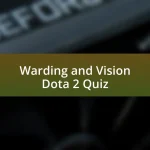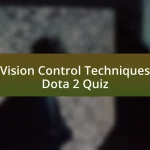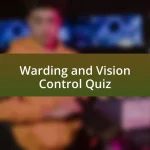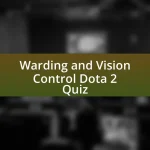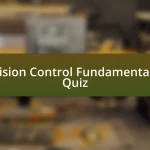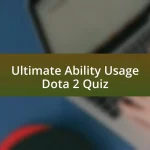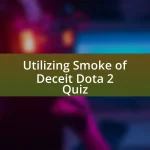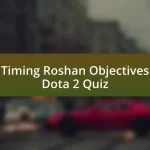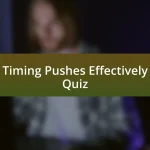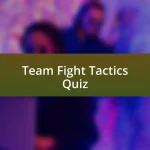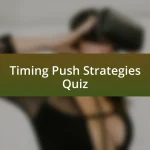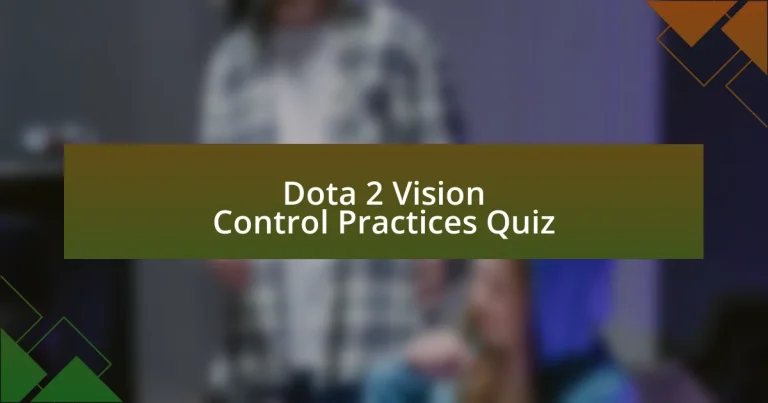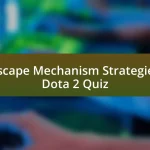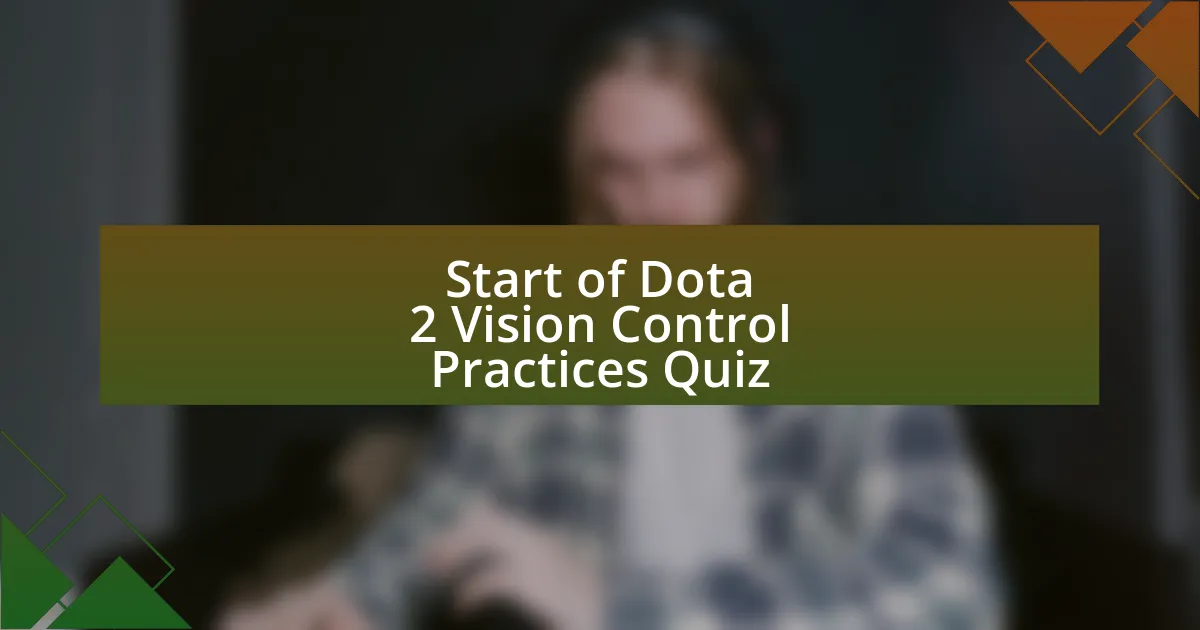
Start of Dota 2 Vision Control Practices Quiz
1. What is the primary role of vision in Dota 2?
- Vision only provides temporary buffs to heroes in combat.
- Vision acts as a damage dealer, increasing the team`s overall attack power.
- Vision directly contributes to controlling the map by providing eyes on key areas such as jungle camps, rune spots, or high ground.
- Vision automatically reveals invisible heroes regardless of placement.
2. How does good vision affect team play?
- Good vision allows players to teleport anywhere on the map instantly.
- Good vision provides safety for cores as they farm, allowing them to maximize gold and experience gain without constantly fearing ganks.
- Good vision increases the team`s total damage output during fights.
- Good vision can eliminate enemy heroes instantly, changing the game`s outcome.
3. What is counter-warding in Dota 2?
- Counter-warding involves using Sentry Wards to destroy enemy wards.
- Counter-warding is about placing wards in enemy territory.
- Counter-warding refers to using Observer Wards for vision.
- Counter-warding is a tactic for gaining gold during the game.
4. Why is dewarding high-value areas important?
- Dewarding high-value areas increases the enemy`s map control and vision advantage.
- Dewarding high-value areas randomly allows for better defense against ganks.
- Dewarding high-value areas removes all wards from the map permanently.
- Dewarding high-value areas forces the enemy to play more cautiously and can give your team the confidence to make bold plays.
5. How should you place Sentry Wards effectively?
- Place Sentry Wards only in jungle areas since they are the safest spots.
- Place Sentry Wards in plain sight to ensure they can spot enemy heroes.
- Place Sentry Wards slightly off the beaten path to catch enemy Observer Wards that are positioned to avoid obvious spots.
- Place Sentry Wards randomly around the map to cover as much ground as possible.
6. What is the focus of late-game vision control?
- Chokepoints in the enemy`s jungle exclusively
- High-priority areas such as Roshan pit
- Areas near your own base only
- Random jungle camps across the map
7. How does smoke ganking relate to vision control?
- Smoke ganking requires knowledge of the enemy’s vision; placing Sentry Wards ensures you are not revealed by enemy wards.
- Smoke ganking only affects the team with better farming ability.
- Smoke ganking relies solely on picking strong heroes for the fight.
- Smoke ganking is unrelated to objective control in the game.
8. What is the strategy behind baiting the enemy with a ward?
- Placing a ward in a hidden location ensures better vision control.
- Using wards only to scout objectives provides valuable information.
- Relying on wards to direct team fights offers strategic advantages.
- Placing a ward in a visible location can attract the enemy, prompting them to deward.
9. How does maintaining vision control evolve during the game?
- Vision control is constant throughout the game, with no need to adapt strategies.
- Vision control evolves by adapting to the game state; in the early game, focus on defensive wards, while in the late game, shift to more aggressive warding.
- Vision control becomes irrelevant as the game progresses, focusing only on team fights and objectives.
- Vision control focuses exclusively on aggressive warding from the start to the end of the game.
10. Who is responsible for maintaining vision control in Dota 2?
- Core heroes
- Support players
- Roshan
- Jungle creeps
11. What items grant temporary vision in Dota 2?
- Observer Wards
- Black King Bar
- Aghanim`s Scepter
- Healing Salve
12. How can a Courier be used as a scout?
- A Courier is mainly used to deliver items to heroes during team fights.
- A Courier, especially an upgraded flying one, can be used as a scout to gain temporary vision of inaccessible areas.
- A Courier can enhance vision by placing Observer Wards in strategic locations.
- A Courier can increase your hero`s damage output when attacking creeps.
13. What abilities reveal small areas around the target?
- Invoker`s Sun Strike
- Zeus`s Lightning Bolt
- Earthshaker`s Fissure
- Faceless Void`s Chronosphere
14. What is the role of Razor`s Static Link in vision control?
- Razor`s Static Link drains health from enemies, increasing damage output permanently.
- Razor`s Static Link provides a shield that absorbs incoming damage for allies.
- Razor`s Static Link can be cast at a target location, revealing the targeted area and providing high ground vision for 2 seconds.
- Razor`s Static Link provides vision to allies when they are near the targeted enemy.
15. How does Manta Style contribute to vision control?
- Manta Style creates two illusions, effectively giving two more points of view and increasing overall vision.
- Manta Style allows heroes to see invisible enemies in a large radius.
- Manta Style grants temporary invulnerability, preventing vision loss.
- Manta Style provides a shield that blocks enemy vision attempts.
16. What is the purpose of using dominated units as scouts?
- Dominated units are primarily for pushing lanes and securing objectives.
- Using dominated units provides additional vision by scouting areas.
- Dominated units are used solely for combat assistance in fights.
- Dominated units can only be used to block enemy paths and not scout.
17. How does Necromonicon contribute to vision control?
- Necromonicon grants temporary invisibility to allies in its vicinity.
- Necromonicon has a level 3 melee unit with true sight, enhancing overall vision control.
- Necromonicon spawns additional units that block enemy movements.
- Necromonicon increases team damage output during team fights.
18. What is the significance of Roshan in vision control?
- Roshan drops additional wards for vision control.
- Roshan`s location provides no strategic advantage.
- Roshan grants a permanent buff to your team.
- Roshan`s defeat reveals enemy positions.
19. How does Tiny contribute to vision control?
- Tiny can stun enemies for longer durations, improving team engagements.
- Tiny can toss friendly units to gain higher ground vision, enhancing overall map awareness.
- Tiny can deal bonus damage to structures, helping to secure objectives faster.
- Tiny can become invisible to escape from dangerous situations, ensuring survival.
20. What is the strategy behind using Plasma Field?
- Plasma Field increases movement speed for allies in the affected area.
- Plasma Field deals damage in a large area, preventing enemy escape.
- Plasma Field reveals units in its wake, providing temporary vision of the area it affects.
- Plasma Field creates a shield that absorbs incoming damage for a short time.
21. How does Rubick contribute to vision control?
- Rubick can use his ultimate to summon illusions, confusing the enemy and providing vision.
- Rubick can place wards that highlight all enemies on the map for a limited time.
- Rubick can teleport allies to safety, allowing them to scout without fear.
- Rubick can use his abilities to reveal enemy positions and disrupt their vision control, making it difficult for them to maintain map awareness.
22. What is the importance of using Watchers in Dota 2?
- Using Watchers provides small but crucial amounts of information about enemy positions, helping teams understand their movements and plan accordingly.
- Using Watchers grants vision of all invisible units permanently.
- Using Watchers allows heroes to teleport anywhere on the map instantly.
- Using Watchers increases damage output significantly during fights.
23. How does Hoodwink contribute to vision control?
- Hoodwink can permanently disable enemy wards, giving her team full control of vision.
- Hoodwink is able to place wards that grant vision in predetermined locations only.
- Hoodwink can use her abilities to move undetected and gain vision of enemy positions, setting up for game-changing ganks or objectives.
- Hoodwink does not contribute to vision control and focuses solely on damage.
24. What is the significance of adapting to the game state in vision control?
- Adapting to the game state is about placing more wards in safe areas only.
- Adapting to the game state involves adjusting warding tactics based on team strength.
- Adapting to the game state refers to avoiding all ward placement.
- Adapting to the game state means reducing vision density to save gold.
25. How does effective communication enhance vision control?
- Effective communication makes individual player actions more unpredictable, enhancing team surprise.
- Effective communication focuses solely on discussing item builds without addressing vision needs.
- Effective communication helps players to farm independently without any regard for map awareness.
- Effective communication ensures that the team maintains vision control in the right areas at the right times, making coordinated plays possible.
26. What is the role of Observer Wards in vision control?
- Observer Wards provide 1500 radius vision for 7 minutes, significantly enhancing overall map awareness.
- Observer Wards increase the damage dealt by heroes in their radius.
- Observer Wards heal allies in the area, providing them with health regeneration.
- Observer Wards grant additional gold to the team when placed in strategic locations.
27. How does Sentry Warding contribute to counter-warding?
- Sentry Warding creates additional vision by placing more Observer Wards on the map.
- Sentry Warding involves using Sentry Wards to detect and destroy enemy Observer Wards, thus blinding them and limiting their map control.
- Sentry Warding requires the use of smoke to conceal the placement of your wards.
- Sentry Warding allows players to teleport to warded locations for quick map control.
28. What is the strategy behind dewarding high-value areas?
- Dewarding high-value areas grants permanent vision for the entire game.
- Dewarding high-value areas forces the enemy to play more cautiously and can give your team the confidence to make bold plays.
- Dewarding high-value areas eliminates all enemy heroes from the map.
- Dewarding high-value areas increases the team`s gold income significantly.
29. How does smoke ganking relate to vision control in the late game?
- Smoke ganking helps avoid detection by enemy wards.
- Smoke ganking increases the number of heroes on the map.
- Smoke ganking provides extra damage in fights.
- Smoke ganking is used to steal buffs from the enemy.
30. What is the significance of maintaining strong vision control during the mid-game?
- Maintaining map control and securing objectives.
- Increasing your hero`s damage output.
- Reducing enemy`s gold per minute.
- Limiting the enemy`s farming opportunities.
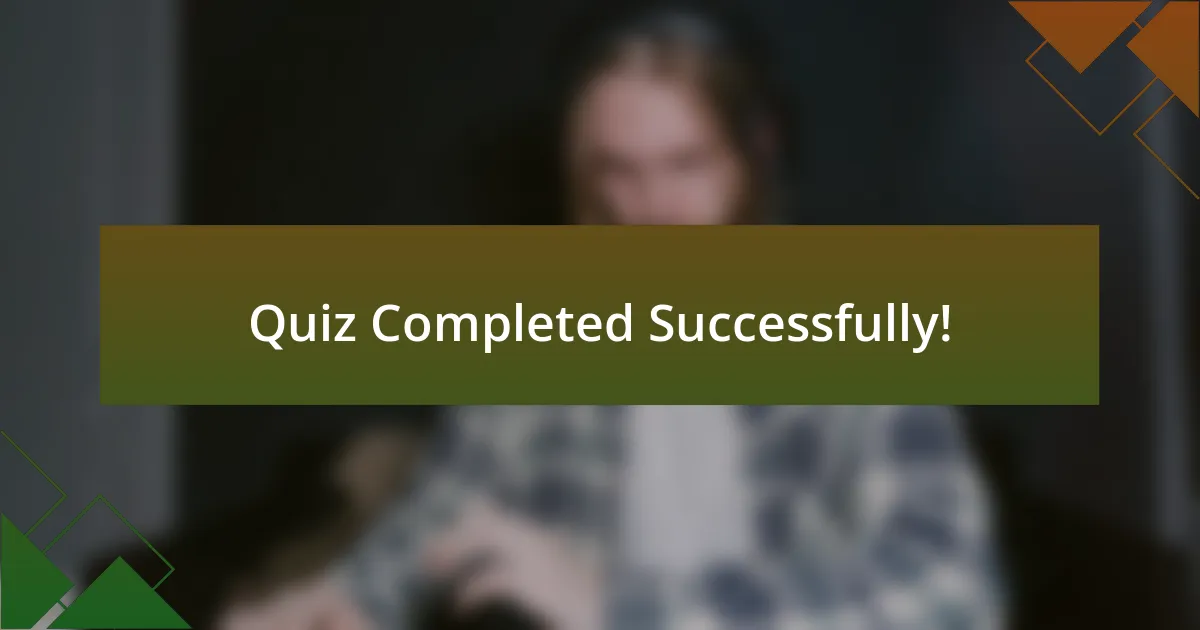
Quiz Completed Successfully!
Congratulations on completing the quiz on Dota 2 Vision Control Practices! This exercise was designed to deepen your understanding of an important aspect of the game. By engaging with the questions, you’ve likely discovered new strategies and insights into how vision can impact matches.
Throughout the quiz, you may have learned about the significance of map awareness. Effective vision control helps in securing objectives and avoiding enemy ambushes. You’ve also explored various tools and techniques for maintaining map control, which can influence the overall flow of the game.
As you continue your journey in mastering Dota 2, we invite you to check the next section on this page. There, you’ll find more detailed information on Dota 2 Vision Control Practices. This resource will further expand your knowledge and elevate your gameplay. Happy learning!
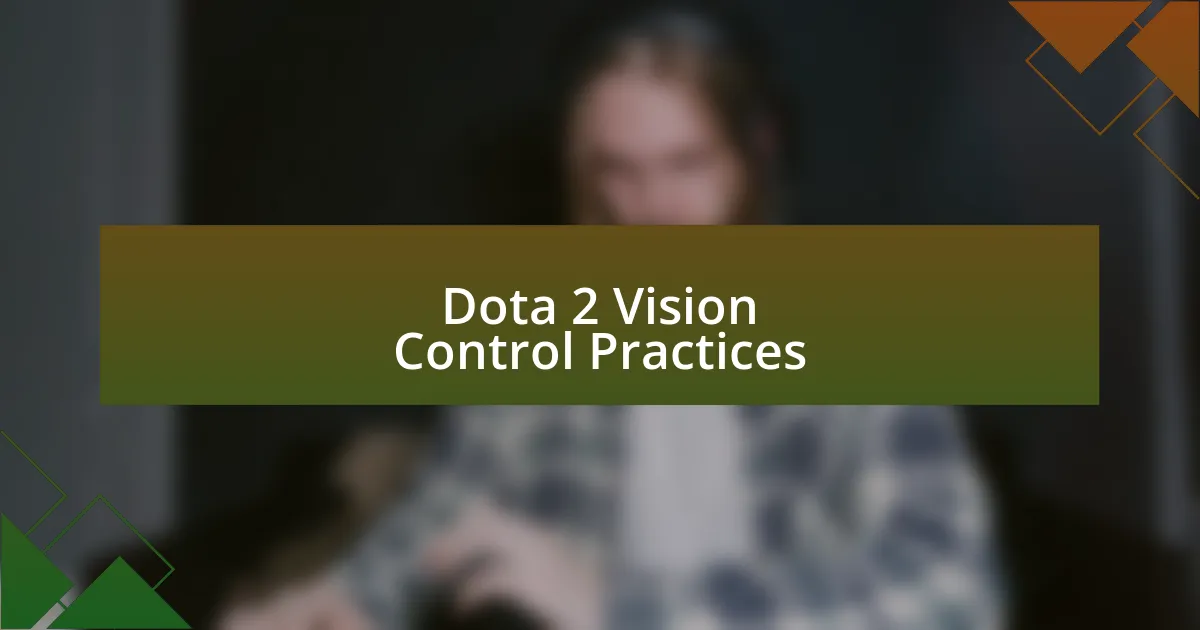
Dota 2 Vision Control Practices
Dota 2 Vision Control Basics
Vision control in Dota 2 refers to the strategic placement and use of wards to gain information about enemy movements and map objectives. Wards are essential tools for ensuring team safety, anticipating ganks, and controlling key areas like Roshan. Proper vision can significantly influence the game by allowing teams to make informed decisions. Players should understand the difference between Observer Wards, which provide vision, and Sentry Wards, which reveal invisible units and destroy enemy wards. An effective warding strategy can shift the balance of power in matches.
Importance of Vision Control
Vision control is crucial in Dota 2 as it provides insight into the enemy’s positioning and tactics. With proper vision, players can avoid ambushes, initiate fights under favorable conditions, and secure objectives. It helps teams make strategic decisions, such as when to push lanes, take Roshan, or retreat. A lack of vision often leads to poor positioning and unnecessary deaths, making vision a foundational element of gameplay. Teams that consistently emphasize vision control gain a tactical advantage leading to increased chances of victory.
Effective Ward Placement Techniques
Effective ward placement involves strategic positioning in key areas of the map to maximize vision. Common techniques include placing wards in high ground locations or areas where enemy heroes are likely to pass. Ideal spots include river entrances, jungle paths, and near objectives like towers. Players should also consider placing wards where vision can be shared with allies. Timing is important; wards should be placed before significant objectives or team fights to gather crucial information. Additionally, vary ward locations to prevent enemies from predicting and countering them.
Dealing with Enemy Vision
Countering enemy vision is essential for maintaining control over the map. Players should routinely scout for enemy wards using Sentry Wards or a Gem of True Sight. It’s important to understand common ward spots and systematically check them. Destroying enemy wards removes their information advantage and can help secure safe passage for ganks or objectives. Additionally, creating distractions by moving as a team to another lane can provide opportunities to clear enemy vision without risk.
Communication and Vision Control
Communication among team members is vital for effective vision control. Players should constantly share information on ward placements and enemy movements. Using voice or text commands to alert teammates about missing enemies or the need for new wards enhances coordination. Teams that effectively communicate about vision control can execute better strategies, avoid danger, and take advantageous fights. Regular review of warding strategies during gameplay can also help teams improve their vision control practices over time.
What is Dota 2 Vision Control?
Dota 2 Vision Control refers to the strategic management of visibility to gain advantages in gameplay. It involves placing and removing wards, using abilities to reveal areas, and maintaining map awareness. Effective vision control can prevent enemy ambushes and facilitate ganks. According to the game’s mechanics, ward placement gives teams information about enemy movements, contributing to better decision-making during matches.
How do players achieve Vision Control in Dota 2?
Players achieve Vision Control by strategically placing Observer and Sentry wards on the map. Observer wards provide vision, while Sentry wards can detect and disable enemy wards. Players also use heroes with abilities that grant vision, such as Night Stalker. Proper timing and awareness of ward expiration times are crucial, as wards typically last for around 6 minutes. This management is reinforced by in-game statistics showing that teams with better vision control win approximately 60% of their matches.
Where are the best spots to place wards for vision control?
The best spots to place wards for vision control include high ground areas, near key objectives such as Roshan or towers, and paths frequently traveled by enemies. Common locations are the river, jungle entrances, and lane choke points. These areas provide extensive visibility over strategic map sections, helping teams track enemy movements. Statistical analysis often indicates that wards placed in these locations significantly increase the chance of spotting enemy ganks or securing objectives before the enemy can react.
When should players prioritize Vision Control?
Players should prioritize Vision Control at the start of the game during the laning phase and right before major objectives, such as Roshan or during team fights. Early game vision can secure lanes and provide information on enemy positions. During crucial moments, maintaining vision can influence the outcome of engagements. Studies of match outcomes reveal that games often turn in favor of teams that secure vision control before executing major strategies.
Who is responsible for Vision Control in a team?
In a Dota 2 team, typically the support players are primarily responsible for Vision Control. Support heroes are equipped with items to place wards and possess the gold for purchasing them. However, all players share responsibility as they need to communicate and coordinate when to buy detection items like Sentry wards. Analysis of professional matches shows that effective vision control involves teamwork, with successful teams often exhibiting a coordinated approach to warding strategies.

